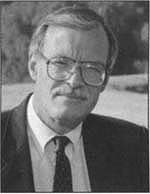All Issues
Competitive grants: Wave of the future?
Publication Information
California Agriculture 49(5):2-2.
Published September 01, 1995
PDF | Citation | Permissions
Full text
In 1985, selenium contamination of Kesterson reservoir and the poisoning of scores of waterfowl led to a permanent augmentation in state research funding and the creation of the UC Salinity Drainage Task Force. Before that, critical needs to reduce overall pesticide use and advance sustainable agriculture led to state funding of the UC Integrated Pest Management Project and the UC Sustainable Agriculture Research and Education Project. However, there have been no such augmentations for nearly 10 years and there is little likelihood that the state will be in a fiscal position to make such augmentations in the foreseeable future.
Partly because of this, the Division has established a competitive grants program, now in its fourth year of operation. With each succeeding year the process for awarding the funds has improved. This year, for the first time, we employed a process similar to that of the National Science Foundation, in which the research and extension proposals were reviewed for scientific merit by eight peer panels. In addition, the Council of Associate Deans and Assistant Directors conducted a programmatic review.
Ultimately, funds were awarded to 32 projects selected from 162 proposals. Final funding decisions were made by the Vice President.
The purpose of the Divisionwide competitive grants program is to provide modest support (up to $20,000) for one year to accomplish research and extension projects that are of high priority from a statewide perspective. The program has been funded at a level of approximately $600,000 annually with Statewide Critical Applied Research funds and temporary moneys available to the Office of the Vice President. Early signs suggest that the program has enabled Division faculty to leverage additional funds from outside sources, and has supported high-priority research and extension activities for which there is no alternative source of funding. We plan to further document the impacts of the competitive grants program with a survey of all grant recipients.
Based on experience with the competitive grants program over the past three years, several members of the Division have suggested informally that the grants program should be expanded. For example, we might provide funding on a competitive basis to support substantial research projects for periods of up to three years. Expansion of the competitive grants program could help to address important challenges. First, the Division needs funds that can be allocated flexibly to respond to high-priority, emerging research needs in a timely fashion. The current patterns of funding allocation within the Division are relatively inflexible. Approximately 88% of our state funds are accounted for by academic salaries and staff salaries. A pool of permanent funds available for allocation through a competitive, peer-reviewed process could provide the flexibility needed to respond to new research priorities quickly.
Second, funding will be needed to support programmatic priorities identified in the Division's mid- and long-term planning processes. The DANR Program Planning Advisory Committees (PPACs) and related processes are broadly participatory; the priorities which emerge from them will reflect the judgments of faculty from throughout the Division. The capacity of the Division to pursue strategic initiatives identified in the planning process and to adapt to rapidly changing internal and external circumstances will depend, in part, on our ability to allocate and reallocate resources flexibly.
Third, with few exceptions, Division funds — even those that are awarded competitively — are reserved for Division faculty. Yet, few would argue that the Division has a monopoly within the University on the expertise needed to address the problems of agricultural, natural and human resources. An expanded competitive grants program would allow us to attract the expertise of all University faculty who are interested in contributing to the Division's mission — not just those within the Division.
Fourth, many signs point to the fact that multidisciplinary research will be needed if we are to address modern research problems. Multidisciplinary research will need to play a larger role than it has historically both in the Division and the University at large. Yet, faculty have few incentives to be involved in multidisciplinary research. An enlarged competitive grants program could introduce such incentives by giving award preferences to such research.
While the arguments favoring an expanded competitive grants program are persuasive there are valid concerns surrounding the question of how such a program might be financed. It appears unlikely that funds to support a competitive grants program could be garnered from external sources. Some Division members are apprehensive that core Division programs could be further downsized to generate funds to support an expanded competitive grants program. Yet, others believe that competitive grants will serve as the catalyst for focusing our core programs more effectively. Despite the controversy, the Division must find ways to develop the flexibility needed to respond to evolving problems in the absence of funding augmentations. It must find ways to make use of the considerable talent of non-Division faculty in addressing the Division's mission. It must find ways of pursuing and supporting the strategic initiatives that emerge from the Division-wide planning process and it must find ways to encourage multidisciplinary research. An enlarged competitive grants program may not be the only answer, but it is one that deserves careful consideration and debate in the coming months.





